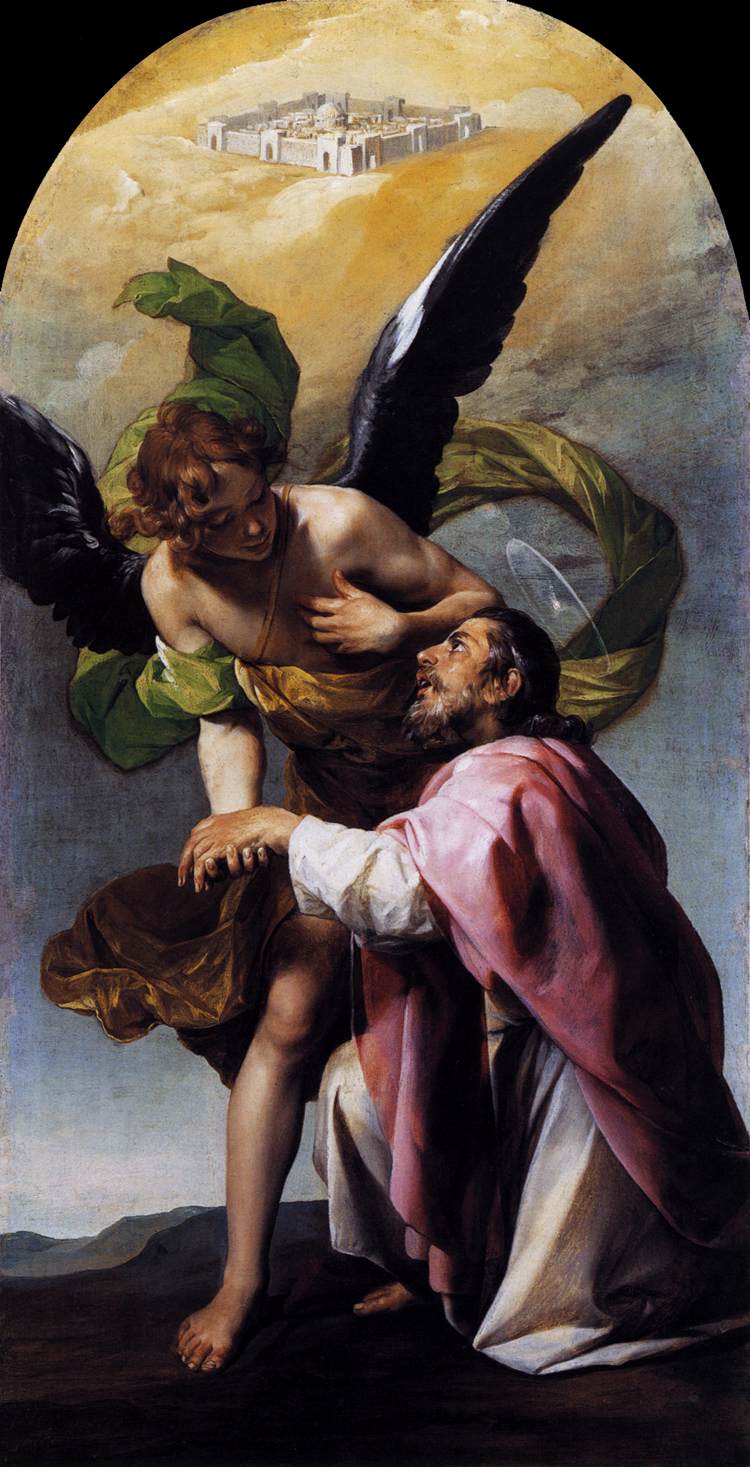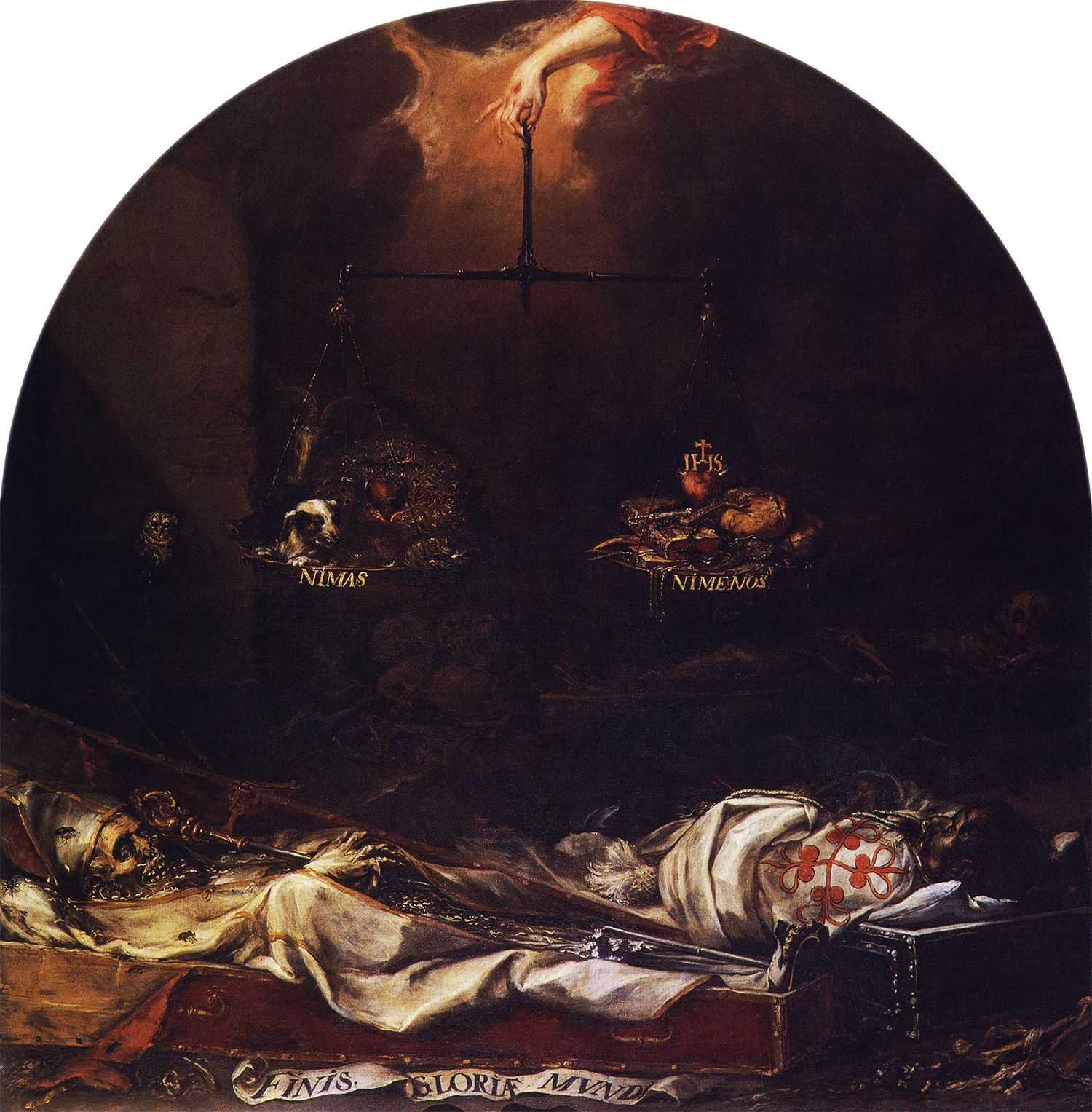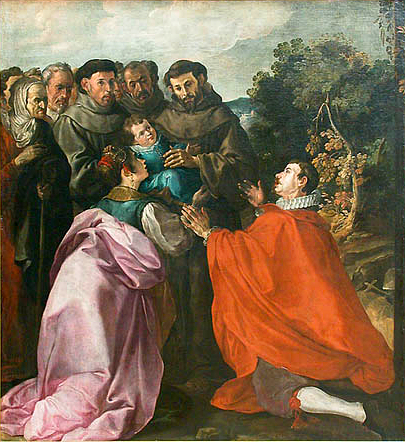|
Juan De Roelas
Juan de Roelas, de las Roelas or Ruela (c. 1570, in Flanders – 1625, in Olivares) was a Flemish painter whose entire documented career took place in Spain. He played a major role in the transition from Mannerist to Baroque painting in Spain. Life Details about the life of the artist are scarce and largely uncertain. Accepted opinion about his life, including his birth in Seville, was overturned in the year 2000 when a Spanish scholar demonstrated that early biographers had mixed up the painter with a contemporary Carmelite canon with the same name who was a native of Seville. The revised view is that the painter Juan de Roelas was not a native of Seville, but was a native of Flanders. The documentary evidence for this was found in two notarial documents which show the presence of a Flemish painter named Juan de Flandes, along with his father, in Valladolid in 1594 (the accepted opinion placed the painter's presence in this city at a later date, somewhere from 1598 to 1 ... [...More Info...] [...Related Items...] OR: [Wikipedia] [Google] [Baidu] |
Francisco Varela (painter)
Francisco Varela (c. 1580 – 1645), was a Spanish Baroque painter. He was born, lived and worked all his life in Seville, where in 1625 a teacher was responsible to check the skills of the aspiring artist to join the guild of painters in the city. As most of the painters of his generation, his was originally a Mannerist style evolved towards naturalism, anticipating in some respects to the model developed later by Francisco de Zurbarán. The work that has come from Varela is scarce. There are two representations of the '' Last Supper'', one of them made in 1622, probably inspired by a mannerist engraving, is located in the Church of San Bernardo in Seville, the other with an iconography very similar, was acquired in 2004 by the Regional Government of Andalusia, is on display at the Museum of Fine Arts of Seville. Also of note is the ''Portrait of Martinez Montanes'' (1616) belonging to the city of Seville and ''San Miguel Archangel'' (1629). One of his last known works, e ... [...More Info...] [...Related Items...] OR: [Wikipedia] [Google] [Baidu] |
Francisco Pacheco
Francisco Pacheco del Río (bap. 3 November 1564 – 27 November 1644) was a Spanish painter, best known as the teacher and father-in-law of Diego Velázquez and Alonzo Cano, and for his textbook on painting, entitled ''Art of Painting'', that is an important source for the study of 17th-century practice in Spain. He is described by some as the "Vasari of Seville": vocal and didactic about his theories of painting and thoughts about painters, conventional and uninspired in his executions.The Paintings of Francisco de Herrera, The Elder, by John S. Thacher. The Art Bulletin (1937); page 328. Early life He was born at Sanlúcar de Barrameda, son of Juan Pérez and wife Leonor del Río, and moved to Seville at a young age. He was a student of Luis Fernandez, and did much of his learning by copying works of the Italian masters. He visited Madrid and Toledo in 1611, studying the work of El Greco, then returned to Seville and opened an art school. He married a daughter of de Mi ... [...More Info...] [...Related Items...] OR: [Wikipedia] [Google] [Baidu] |
Jacopo Bassano
Jacopo Bassano (c. 1510 – 14 February 1592), known also as Jacopo dal Ponte, was an Italian painter who was born and died in Bassano del Grappa near Venice, and took the village as his surname. Trained in the workshop of his father, Francesco the Elder, and studying under Bonifazio Veronese in Venice, he painted mostly religious paintings including landscape and genre scenes. He often treated biblical themes in the manner of rural genre scenes, portraying people who look like local peasants and depicting animals with real interest. Bassano's pictures were very popular in Venice because of their depiction of animals and nocturnal scenes. His four sons: Francesco Bassano the Younger, Giovanni Battista da Ponte, Leandro Bassano, and Girolamo da Ponte, also became artists and followed him closely in style and subject matter. Life He was born around 1510 in the town of Bassano del Grappa, located about 65 km from the city of Venice. His father, Francesco il Vecchio, was a l ... [...More Info...] [...Related Items...] OR: [Wikipedia] [Google] [Baidu] |
Paolo Veronese
Paolo Caliari (152819 April 1588), known as Paolo Veronese ( , also , ), was an Italian Renaissance painter based in Venice, known for extremely large history paintings of religion and mythology, such as ''The Wedding at Cana'' (1563) and ''The Feast in the House of Levi'' (1573). Included with Titian, a generation older, and Tintoretto, a decade senior, Veronese is one of the "great trio that dominated Venetian painting of the ''cinquecento''" and the Late Renaissance in the 16th century.Rosand, 107 Known as a supreme colorist, and after an early period with Mannerism, Paolo Veronese developed a naturalist style of painting, influenced by Titian. His most famous works are elaborate narrative cycles, executed in a dramatic and colorful style, full of majestic architectural settings and glittering pageantry. His large paintings of biblical feasts, crowded with figures, painted for the refectories of monasteries in Venice and Verona are especially famous, and he was also the leadi ... [...More Info...] [...Related Items...] OR: [Wikipedia] [Google] [Baidu] |
History Of Seville
Seville has been one of the most important cities in the Iberian Peninsula since ancient times; the first settlers of the site have been identified with the Tartessian culture. The destruction of their settlement is attributed to the Carthaginians, giving way to the emergence of the Roman city of Hispalis, built very near the Roman colony of Itálica (now Santiponce), which was only 9 km northwest of present-day Seville. Itálica, the birthplace of the Roman emperors Trajan and Hadrian, was founded in 206–205 BC. Itálica is well preserved and gives an impression of how Hispalis may have looked in the later Roman period. Its ruins are now an important tourist attraction. Under the rule of the Visigothic Kingdom, Hispalis housed the royal court on some occasions. In al-Andalus (Muslim Spain) the city was first the seat of a ''kūra'' (Spanish: ''cora''), or territory, of the Caliphate of Córdoba, then made capital of the Taifa of Seville (Arabic: طائفة أشبيلي� ... [...More Info...] [...Related Items...] OR: [Wikipedia] [Google] [Baidu] |
Juan De Valdés Leal
Juan de Valdés Leal (4 May 1622 – 15 October 1690) was a Spanish painter and etcher of the Baroque era. Career Valdés was born in Seville in 1622. He became a painter, sculptor, and architect. By his twenties, he was studying under Antonio del Castillo in Córdoba. Among his works are ''History of the Prophet Elias'' for the church of the Carmelites; ''Martyrdom of St. Andrew'' for the church of San Francesco in Córdoba; and ''Triumph of the Cross'' for la Caridad in Seville. He became friends with Bartolomé Esteban Murillo, who had a very different style; Leal tended to paint somber and dramatic subjects, while Murillo's style was peaceful and serene. After Leal returned to Seville in 1656, he and Murillo founded the Seville Academy of Art. Several of his paintings treat the subjects of vanitas, transience and mortality. Two examples are ''In ictu oculi'' ("in the blink of an eye") and '' Finis gloriae mundi'' ("end of the world's glory"), painted for the Charity H ... [...More Info...] [...Related Items...] OR: [Wikipedia] [Google] [Baidu] |
Bartolomé Esteban Murillo
Bartolomé Esteban Murillo ( , ; late December 1617, baptized January 1, 1618April 3, 1682) was a Spanish Baroque painter. Although he is best known for his religious works, Murillo also produced a considerable number of paintings of contemporary women and children. These lively realistic portraits of flower girls, street urchins, and beggars constitute an extensive and appealing record of the everyday life of his times. He also painted two self-portraits, one in the Frick Collection portraying him in his 30s, and one in London's National Gallery portraying him about 20 years later. In 2017–18, the two museums held an exhibition of them. Childhood Murillo was probably born in December 1617 to Gaspar Esteban, an accomplished barber surgeon, and María Pérez Murillo. He may have been born in Seville or in Pilas, a smaller Andalusian town. It is clear that he was baptized in Santa Maria Magdalena, a parish in Seville in 1618. After his parents died in 1627 and 1628, he became ... [...More Info...] [...Related Items...] OR: [Wikipedia] [Google] [Baidu] |
Juan Del Castillo
Juan del Castillo (c. 1590 – c. 1657) was a Spanish Baroque painter. Many of his paintings became famous during his time due to his pupil, Bartolomé Esteban Murillo. Del Castillo was the youngest brother of the painter Agustín. Both were trained in painting by Luis Fernández in Seville. Afterwards he painted religious frescoes and oil paintings around Seville, and also in Granada and Cádiz. Amongst his students were his brother-in-law Alonso Cano and his nephew Antonio, as well as Bartolomé Esteban Murillo, Pedro de Moya, Andro de Medina and Juan de Valdés Leal Juan de Valdés Leal (4 May 1622 – 15 October 1690) was a Spanish painter and etcher of the Baroque era. Career Valdés was born in Seville in 1622. He became a painter, sculptor, and architect. By his twenties, he was studying under Anto ....A. O'Neil''Castillo (Juan del)'' A Dictionary of Spanish Painters, 1833, p. 65. His work was influenced by Venetian style. References 1590s births 1650s ... [...More Info...] [...Related Items...] OR: [Wikipedia] [Google] [Baidu] |
Francisco Herrera The Elder
Francisco Herrera (1576–1656) was a distinguished Spanish painter, born in Seville. He was the founder of the Seville school. Biography Francisco Herrera was born in Seville in 1576. Francisco Pacheco was his teacher, but Herrera soon broke away from the timid style and Italian traditions of Spanish painting of his day, and became the pioneer of that bold, vigorous, effective, and natural style whose preeminent exponent was Velázquez. Herrera was the first to use long brushes, which may, in part, account for his "modern" technique and dexterous brushwork. Many authorities ascribe to him the foundation of the Spanish School. His great talent brought him many pupils, whom his passionate temper and rough manners soon drove away. Velázquez, when thirteen years old, was placed under this great professor, and remained a year with him. Herrera, who was an accomplished worker in bronze, engraved medals skilfully. This gave rise to the charge of counterfeiting, and he fled for sanc ... [...More Info...] [...Related Items...] OR: [Wikipedia] [Google] [Baidu] |
Alonzo Cano
Alonso Cano Almansa or Alonzo Cano (19 March 16013 September 1667) was a Spanish painter, architect, and sculptor born in Granada.Alonso Cano – article Biography  He learned architecture from his father, ;
He learned architecture from his father, ; [...More Info...] [...Related Items...] OR: [Wikipedia] [Google] [Baidu] |







